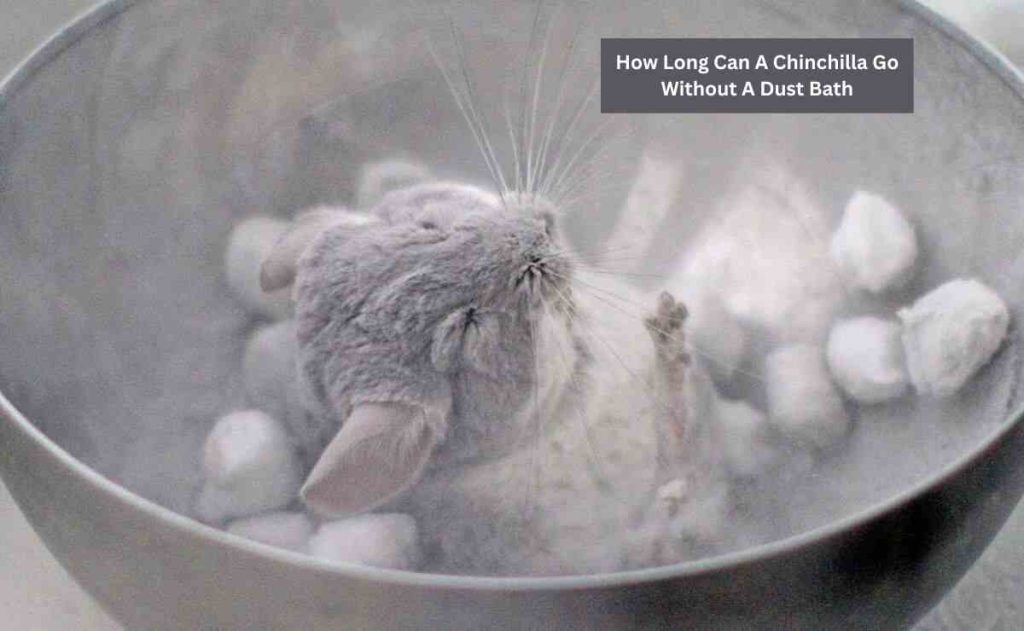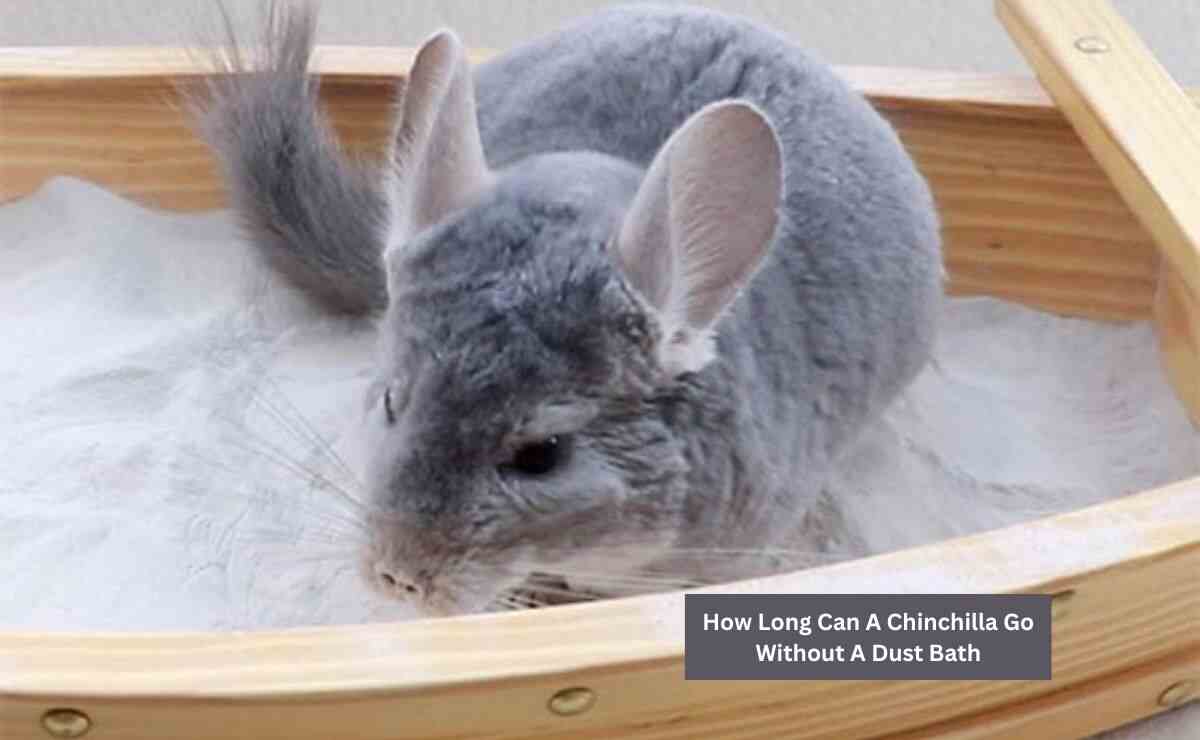Chinchillas should not take a water bath. They always require a dust bath to stay clean. Sometimes you can’t manage dust for their bath, but you should know how long can a chinchilla go without a dust bath.
Dust bath gives your chinchillas a clean and healthy appearance. However, a chinchilla can go a few days like 4 to 5 days or even a week without a dust bath. After the period, its fur gets greasy and spreads an unpleasant odor. Scroll on to learn more details.
How Long Can A Chinchilla Go Without A Dust Bath?

Chinchillas require a dust bath to maintain their hygiene and keep their fur healthy. They have a dense fur coat that can be prone to matting and oil buildup, so regular dust baths are necessary to keep their fur in optimal condition.
A chinchilla could go its whole life without a dust bath. But hold on – before you think of your chinchilla as a low-maintenance pet, here’s the catch. If you skip the dust bath routine, your furry friend might end up looking like it rolled in the dirt intentionally.
Now, I know you care about your pet, and skipping dust baths might seem a bit cruel. While it won’t necessarily be a life-or-death situation for your chinchilla, it’s not recommended. If you ever run out of dust or find yourself on holiday without the means for a dust bath, don’t panic. Your chinchilla can endure a week or two without a bath, but it’s better not to push it.
While chinchillas can tolerate short periods without a dust bath, it is not ideal for their overall health. The dust bath helps to remove excess oils, dirt, and debris from their fur, which can prevent skin issues and clumpy fur.
Ideally, a chinchilla should have access to a dust bath at least once every other day. This allows them to engage in natural behavior and keep their fur clean and healthy. However, if a chinchilla is unable to have a dust bath for a few days due to circumstances such as travel or illness, it should not cause immediate harm.
Chinchillas have natural oils on their fur that help to keep it healthy and repel moisture. When they are unable to have a dust bath, their fur may become slightly oily or greasy. This is not a cause for immediate concern, but it is important to provide them with a dust bath as soon as possible to maintain their hygiene and prevent any potential skin issues.
Why Is Dust Bath Important For Chinchillas?
As you know chinchillas have quite dense fur compared to other animals, even humans. They have up to 70 hairs per follicle on their skin, making chinchillas coat not just dense but luxuriously soft to the touch.
Now, as fabulous as this may sound, dense fur comes with its challenges, especially when it comes to getting wet. In the wild or the cozy confines of captivity, a wet chinchilla translates to an extended drying time.
You see, the problem with wet fur is not just inconvenience; it could lead to serious consequences. Damp hair becomes a breeding ground for mold, and your beloved pet might end up sick from being wet and cold. Now, I’m sure you want to keep your chinchilla in the best possible health. So, here’s where the necessity of dust baths comes in.
Chinchillas have naturally built up an amazing way to sidestep the wet fur dilemma – they simply don’t get wet. Instead of water, they indulge in dust baths.
The dust bath soaks up any excess oil and dirt lingering on their skin and fur, leaving them not only looking fresh but also maintaining their overall health.
What Happens If You Don’t Give a Chinchilla a Dust Bath?
Bath means cleanliness and it is as important for humans as it is for chinchillas. When a chinchilla doesn’t get a dust bath for a longer period, you can notice a change in the texture of its fur. It becomes oilier and dirtier, and you can feel the difference when you handle your pet.
Without a dust bath, chinchilla’s fur gets clumps up due to oil and dust. As a result, it will feel irritating and uncomfortable. This situation increases the chances of excessive grooming, biting, and mutilation.
You have to be careful while giving dust bath to chinchilla as dusts may cause irritation in the human respiratory system.
If a chinchilla goes without a dust bath for an extended period, such as a week or more, there is a higher risk of skin issues and fur matting. Without the regular removal of oils and dirt, their fur can become matted and can lead to discomfort and potential health issues such as overheating or fungal infections.
In their natural habitat, wild chinchillas take advantage of the fine dust and dirt found in the foothills. They roll around in this dust, and it works like a charm. It absorbs any oil or moisture in the fur. As the chinchilla rolls around, the dust picks up the oil, and the rolling motion dislodges it.
Now, here’s a relatable comparison – it’s akin to how talcum powder works. Some people even use cornflour for a similar purpose. While these alternatives aren’t as good as a proper dust bath, they’re better than doing nothing. This is especially true for chinchillas because once their fur gets wet, drying becomes a bit of a challenge.
How Often Should I Bathe My Chinchilla?
Bathing your chinchilla is an essential part of their care routine. You should maintain the frequency of their bathing. Too much of a good thing can lead to trouble. You should never exceed four baths a week, as overdoing it could result in drying out your chinchilla’s precious skin.
If you and your chinchilla reside in a hot and humid area, the heat can make your chinchilla sweat more, leading to increased production of natural oils on their fur. On the other side, if you’re in a colder climate, where your chinchilla isn’t sweating as much, twice a week should be sufficient.
A dust bath should be kept short and sweet, lasting around three to five minutes. After this time, remove the dust bath house from your chinchilla’s enclosure to avoid any confusion with a litter box. Even better, take your chinchilla out of the cage for its dust bath – cleaning up the dust outside the cage is much easier.
Now, when it comes to saving the dust, you can reuse it a few times, but be mindful. Discard the dust if it starts clumping together or looks particularly dirty – dirty dust won’t do much to keep your chinchilla clean.
Chinchillas generally need dust baths every 2 to 3 days, totaling 2 to 4 dust baths per week. The frequency depends on your environment and the current climate.
Conclusion
Chinchillas can tolerate short periods without a dust bath, but it is important to provide them regularly. It is helpful to maintain their hygiene and overall health.
If circumstances arise where a chinchilla cannot have a dust bath for an extended period like over two weeks, you should arrange it as soon as possible to prevent any negative consequences. But don’t push the time intentionally. Always prefer your pet’s cleanliness and maintain hygiene.
